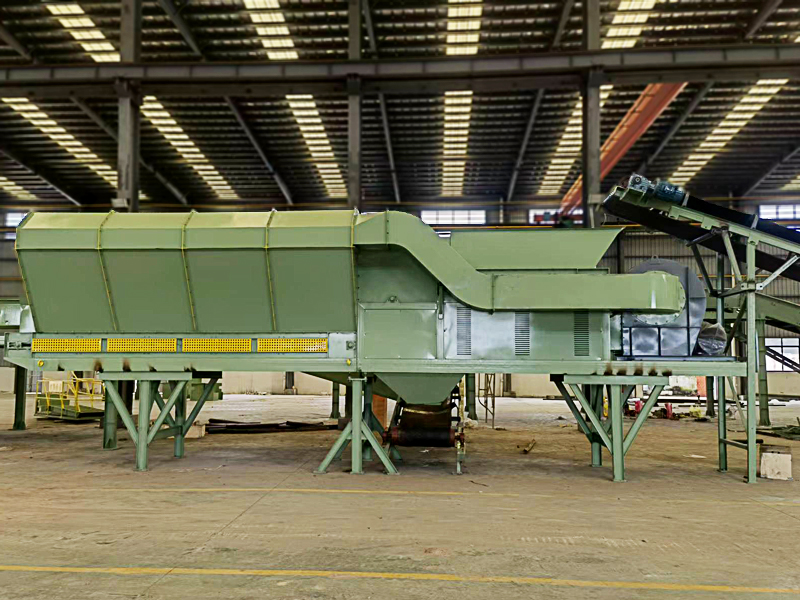Energy-efficient separator windsifter
Windsifter is a device that uses airflow to separate and classify particles of different densities or sizes. It is widely used in mining, chemical, food, pharmaceutical and other industries to separate materials for effective material processing and utilization. The following is the working principle and main features of windsifter.

Working principle:
1. Airflow conveying: The material enters the windsifter through the feed port, and the airflow is generated by equipment such as fans. The high-speed airflow suspends the material and transports it to the sorting area.
2. Sorting area: In the sorting area, the speed and direction of the airflow will affect the movement trajectory of the material. Light particles are brought to the upper part due to the action of the airflow, while heavy particles sink due to gravity.
3. Classification:
- Light materials: are lifted by the airflow and enter the upper layer or outlet of the airflow to become light products.
- Heavy materials: are left at the bottom of the separator due to gravity and are eventually discharged as heavy products.
4. Adjustment parameters: By adjusting the airflow speed, flow rate and internal design of the separator, it is possible to separate particles of different sizes and densities and optimize the separation effect.
Main features:
- Efficient sorting: It can efficiently separate materials, especially suitable for the classification of light and heavy materials.
- Strong flexibility: The working parameters can be adjusted according to the material characteristics to meet different sorting needs.
- Low energy consumption: Compared with other sorting equipment, windsifter consumes less energy during operation.
Application areas:
- Mining: Separation of metal ores and impurities.
- Chemical industry: Separation of chemicals of different particle sizes.
- Food: Screening of grains, sugar, salt, etc.
- Pharmaceutical: Separation of drug powder, etc.
-
 Trommel screenTrommel screen, also known as drum screens, are widely used in various industries for sorting and separating materials.Get Quote
Trommel screenTrommel screen, also known as drum screens, are widely used in various industries for sorting and separating materials.Get Quote -
 Crop straw double shaft shreddApplications:Biomass Energy Production: Shredded straw can be used as a feedstock for bioenergy plants to produce electricity or heat.Livestock Feed: Reduced-si...Get Quote
Crop straw double shaft shreddApplications:Biomass Energy Production: Shredded straw can be used as a feedstock for bioenergy plants to produce electricity or heat.Livestock Feed: Reduced-si...Get Quote -
 Zhongcheng Air Drum SeparatorAir drum separators effectively separate lightweight materials (e.g., plastics, paper) from heavier materials (e.g., metals, glass). This high efficiency is cru...Get Quote
Zhongcheng Air Drum SeparatorAir drum separators effectively separate lightweight materials (e.g., plastics, paper) from heavier materials (e.g., metals, glass). This high efficiency is cru...Get Quote
-
2024-07-16Twin-shaft shredders: ideal for efficient processing of waste and recycling materialsA double-shaft shredder is a mechanical device used to process waste and recycle materials. Its main feature is that it has two rotating shafts with serrated bl...
-
2024-06-06Drum Screen For Composting PlantDrum screen, also known as a rotary drum screen or trommel screen, is an essential piece of equipment used in composting plants for the separation of compost ma...
-
2024-06-08Solutions for Jaw Crusher ProblemsJaw crusher is widely used in mining, smelting, building materials, highways, railways, water conservancy and chemical industries. The maximum compressive stren...
-
2023-01-12Impact CrusherImpact crusher is a type of machine designed to reduce large rocks, ores, and other hard materials into smaller, more manageable pieces. This equipment is widel...
-
2024-05-20Mobile Impact Crusher PlantThe mobile impact crusher plant is a kind of crushing equipment based on a mobile platform. It uses an impact crusher as the host machine and is usually equippe...



